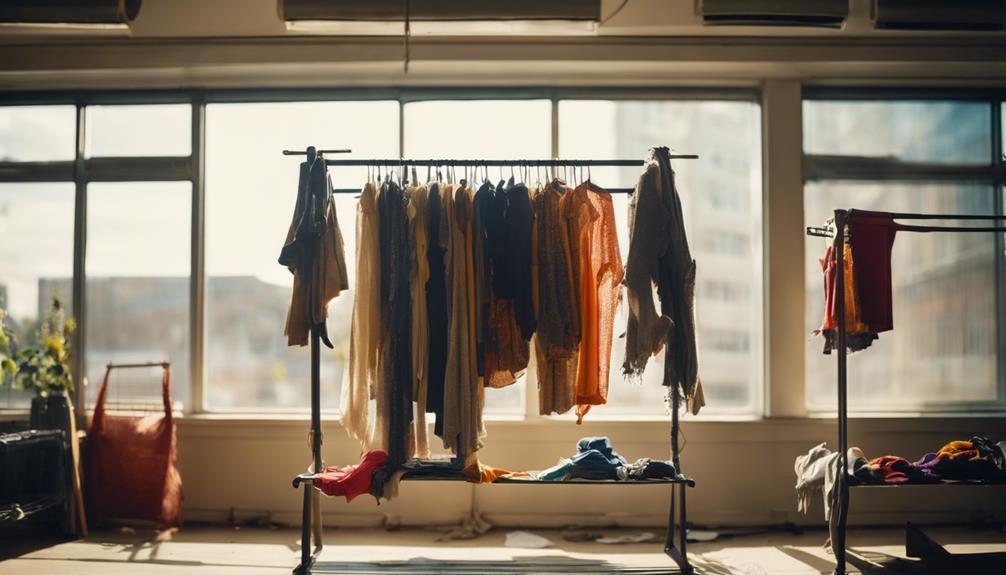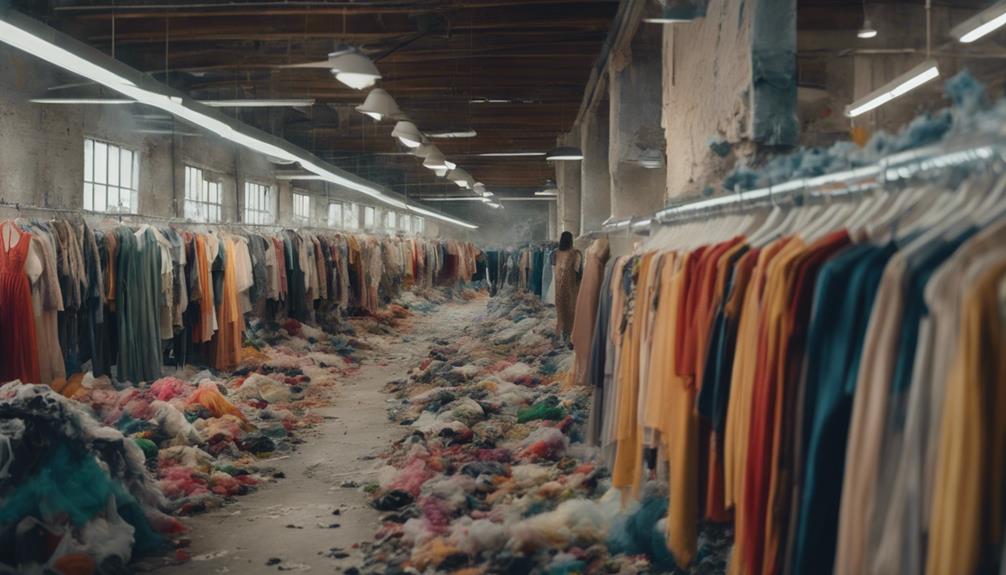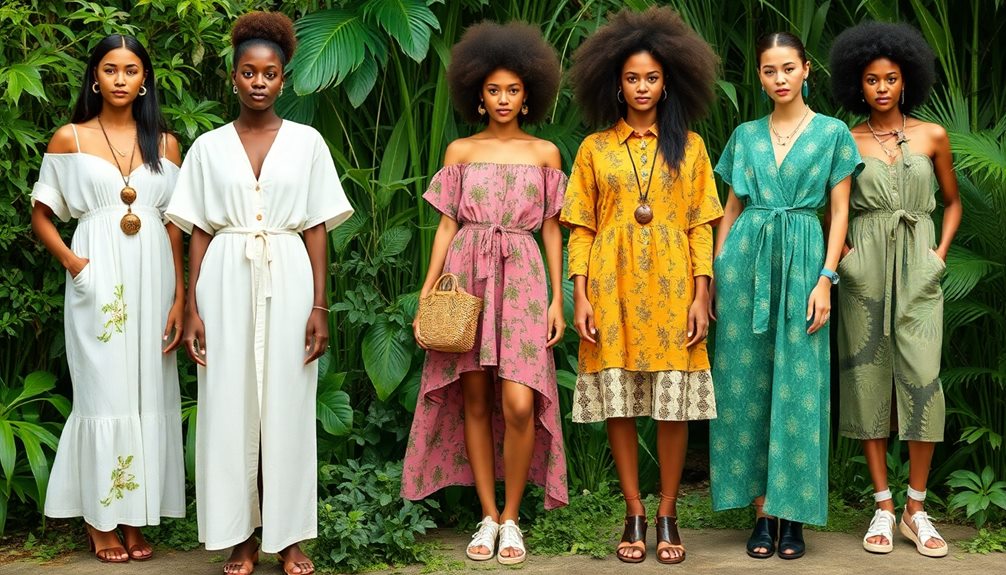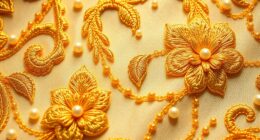Sustainable fashion is not just a passing fad; it is a crucial response to the environmental crisis. Given that the fashion industry contributes to 8% of global greenhouse gas emissions, it is evident why this shift is important. Many consumers, particularly millennials, are now prioritizing sustainable options when making purchases. By adopting innovations like recycled materials and supporting resale markets, you can help decrease waste and have a positive impact. As you educate yourself on sustainable practices, you will uncover opportunities to shop responsibly and contribute to a healthier planet for future generations. Interested in making these choices? There is plenty to explore!
Key Takeaways
- Sustainable fashion is not just a trend; 71% of millennials prioritize sustainability in their shopping choices, indicating a shift in consumer values.
- The fashion industry's significant impact, contributing 8% of global greenhouse gas emissions, drives the urgent need for sustainable practices.
- Resale markets are growing rapidly, projected to surpass fast fashion by 2028, reflecting changing consumer behaviors toward eco-friendly options.
- Corporate accountability and transparency are essential for genuine sustainability; consumers demand brands to integrate eco-friendly practices into their supply chains.
Understanding Sustainable Fashion
Sustainable fashion focuses on minimizing the environmental and social harm caused by clothing production and consumption, making it essential for a healthier planet. It addresses critical issues like waste, pollution, and unethical labor practices, ensuring that your choices contribute positively to the world.
You mightn't realize that the fashion industry is responsible for 8% of global greenhouse gas emissions, with a staggering 60% of clothing items tossed into landfills or incinerated within a year. This reality underscores the urgent need for sustainable alternatives.
By embracing sustainable fashion, you can help shift these harmful trends. Innovations in materials like recycled polyester and organic cotton are paving the way for a more eco-friendly wardrobe.
As a consumer, your awareness matters; 71% of millennials prioritize sustainability when shopping, reflecting a growing demand for responsible purchasing.
Additionally, the resale market for second-hand clothing is predicted to surpass fast fashion by 2028, showcasing a significant change in attitudes toward sustainability.
Understanding sustainable fashion isn't just about trends; it's about making informed choices that support ethical practices and environmental health, ultimately benefiting both you and the planet. Sustainable fashion impact on class can help to bridge the gap between social and economic disparities, ensuring that all individuals have access to ethically-produced and environmentally-friendly clothing. By making conscious decisions about where we purchase our clothing and supporting brands that prioritize sustainable practices, we can contribute to a more equitable and sustainable fashion industry. This not only benefits the environment, but also promotes social responsibility and equality within the fashion community.
The Environmental Crisis in Fashion
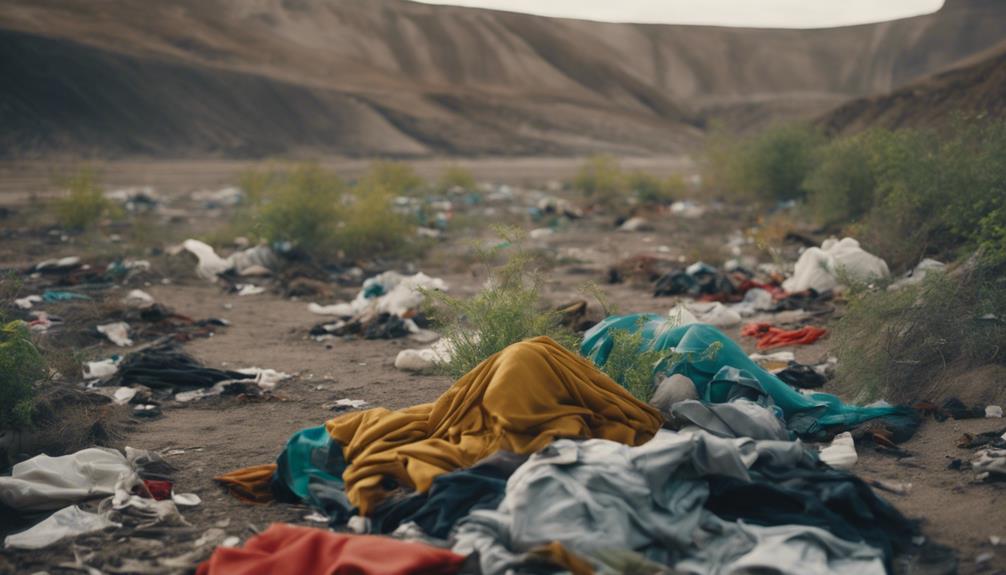
The fashion industry's environmental crisis is driven by excessive waste, pollution, and the harmful practices embedded in clothing production. You mightn't realize it, but your wardrobe contributes considerably to this issue.
Consider these alarming facts about the environmental impact of fashion:
- Greenhouse Gas Emissions: The industry accounts for 8% of global greenhouse gas emissions, fueling climate change.
- Waste Generation: Around 60% of clothing items are tossed within a year of purchase, often ending up in landfills or incinerators.
- Recycling Rates: A mere 1% of discarded clothing is recycled, leading to an annual loss of $100 billion due to wasted resources.
- Chemical Usage: Clothing production uses about 8,000 synthetic chemicals, with only 16 deemed safe by the EPA, raising serious environmental safety concerns.
With fashion waste projected to hit 148 million tons by 2030, it's clear that the current practices aren't sustainable.
You have the power to change this narrative by making conscious choices in your fashion consumption. It's time to rethink how you shop and wear clothes.
Resale Market Growth

You might've noticed a shift in how people shop, with many turning to resale markets for their fashion needs.
This trend isn't just about saving money; it also reflects a growing awareness of environmental impacts.
As consumer mindsets change, you'll see more people embracing second-hand clothing as a sustainable alternative to fast fashion.
Economic Shift Towards Resale
An economic shift is driving consumers, especially younger generations, to embrace the resale market as a viable alternative to fast fashion. This trend shows no signs of slowing down, as the resale fashion market is projected to surpass fast fashion by 2028.
Here are some key reasons why this shift is happening:
- Affordability: Younger consumers are seeking cost-effective ways to build their wardrobes without sacrificing style.
- Sustainability: There's a growing awareness of the environmental impact of fashion, leading many to prefer second-hand options.
- Access to Unique Pieces: Resale markets offer one-of-a-kind items that help individuals express their personal style, unlike mass-produced fast fashion.
- Changing Attitudes: Companies like RealReal are transforming how you view second-hand items, making them more desirable and socially acceptable.
As you explore the resale fashion scene, you'll find that it not only meets your budgetary needs but also aligns with a broader commitment to sustainability.
This economic shift reflects a significant change in purchasing habits, showing that resale fashion is more than just a trend; it's a movement towards a more conscious consumer culture.
Environmental Benefits of Resale
Resale fashion greatly reduces environmental impact by extending the life cycle of clothing, minimizing waste, and lowering carbon emissions associated with new production. As you embrace second-hand shopping, you contribute to a sustainable future while enjoying unique finds.
The impressive growth of the resale market showcases its environmental benefits:
| Year | Market Value | Projected Growth |
|---|---|---|
| 2021 | $36 billion | – |
| 2025 | $77 billion | 114% increase |
| 2028 | Surpass fast fashion | – |
| 2023 | – | Substantial rise |
Every second-hand item sold prevents the need for new production, which can greatly reduce waste and carbon emissions. With young consumers, especially Gen Z, prioritizing sustainability, the shift towards resale fashion is more than just a trend; it's a movement. Companies like RealReal and ThredUp are leading the way, raising awareness about sustainable practices while making it easier for you to shop responsibly. By participating in the resale market, you're not just saving money; you're actively supporting a sustainable approach that benefits our planet.
Changing Consumer Mindsets
Growing awareness of sustainability is transforming consumer mindsets, making second-hand shopping a preferred choice for many. This shift is evident as the resale fashion market is projected to outpace fast fashion by 2028. Younger generations are increasingly prioritizing sustainability, leading to a significant change in how you approach fashion consumption.
Here are some key factors contributing to this transformation:
- Economic Benefits: Second-hand items often cost less, making them budget-friendly options.
- Environmental Impact: By choosing resale, you're reducing waste and minimizing your carbon footprint.
- Unique Finds: Vintage and unique pieces allow you to express your individuality without conforming to fast fashion trends.
- Social Responsibility: Supporting resale platforms like RealReal aligns your shopping habits with eco-conscious values, as 71% of millennials now prioritize sustainability.
Your changing consumer mindsets reflect a broader cultural shift towards valuing sustainability and ethical consumption in fashion. By embracing second-hand shopping, you're not just saving money but also contributing to a more sustainable future.
Corporate Responsibility and Accountability
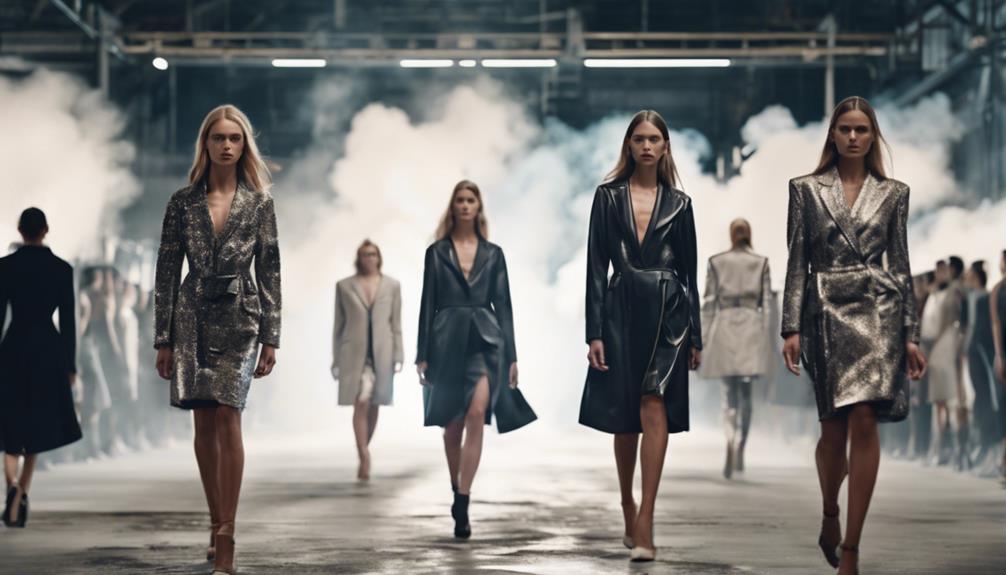
When you consider corporate responsibility in fashion, you expect genuine commitment, not just a marketing ploy.
As consumers, you deserve transparency and accountability, pushing brands to back their sustainability claims with real changes.
Regulatory measures are becoming essential to guarantee companies align their practices with the values they promote.
Genuine Commitment Required
Many brands claim to prioritize sustainability, but without genuine commitment to Corporate Social Responsibility, their efforts often come off as mere marketing ploys. You might feel skeptical, and rightly so. It's essential to recognize that real change requires more than just surface-level initiatives.
Here are four key aspects that demonstrate a genuine commitment to sustainability:
- Integration into Core Operations: Brands need to embed sustainable practices within their entire supply chain, not just in isolated campaigns.
- Transparency and Accountability: Companies must openly share their sustainability goals and the progress they're making, allowing you to hold them accountable.
- Tangible Changes: Effective CSR involves making substantial modifications in production methods and materials, rather than just adopting trendy eco-labels.
- Consumer Education: Brands should work to educate you about sustainability, helping you make informed choices that align with your values.
Regulatory Measures Needed
Without regulatory measures, the fashion industry's claims of sustainability will continue to lack accountability and meaningful impact. You're likely aware that a staggering 87% of garments end up in landfills or incinerators each year. This waste reflects a system where companies can tout sustainability without real consequences for their actions. The fashion industry needs robust regulations to hold companies accountable for their environmental impact.
Government intervention can enforce sustainable practices, ensuring that businesses internalize the costs of their negative environmental effects rather than passing them onto society. You should demand more than superficial branding strategies; effective corporate social responsibility (CSR) requires genuine changes in operations and supply chains.
When consumers like you are willing to pay a premium for sustainable fashion, you deserve assurance that your investment truly contributes to a healthier planet. By implementing the regulatory measures needed, we can bridge the gap between marketed sustainability claims and actual practices. This won't only elevate industry standards but also empower you to make informed choices that align with your values.
Ultimately, meaningful change in the fashion industry hinges on accountability, and that starts with regulations.
Consumer Behavior Shifts

You might notice that younger generations are increasingly making eco-conscious choices, reflecting a significant shift in consumer behavior toward sustainable fashion. This change is largely driven by the values of Gen Z and millennials, who prioritize sustainable products when making purchasing decisions. They hold substantial purchasing power, with Gen Z alone accounting for over 40% of it.
Here are some key trends shaping this shift:
- Sustainability Priority: 71% of millennials prioritize sustainability in their shopping habits.
- Resale Revolution: The resale fashion market is set to outpace fast fashion by 2028, as younger consumers embrace second-hand clothing.
- Willingness to Pay: 92% of Indian adults are ready to spend more on sustainable products, showing a growing global trend.
- Price vs. Ethics: Despite valuing sustainability, many still choose price over ethical considerations, highlighting a disconnect in consumer behavior.
These trends suggest that while sustainable fashion is gaining traction, there's a complex interplay of values and purchasing decisions. Understanding these shifts can help brands better align with consumer expectations and drive meaningful change in the industry.
Regulatory Needs for Sustainability
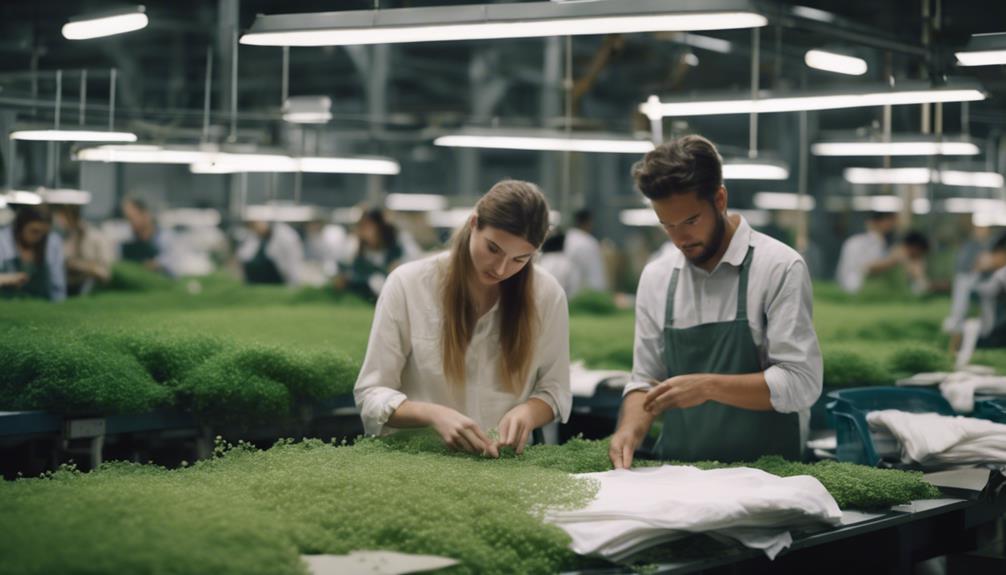
Regulatory measures are vital to guarantee the fashion industry adopts sustainable practices and holds companies accountable for their environmental impact. Without these regulations, the industry continues to produce a staggering 150 billion garments annually, contributing considerably to climate change and the exploitation of factory workers.
You might be surprised to learn that, despite claims of sustainability, the environmental impacts have barely changed over the past 25 years. This highlights the urgent regulatory needs for sustainability.
Only 1% of discarded clothing gets recycled, emphasizing the necessity for frameworks that promote recycling and circular business models. Market-based solutions alone have proven ineffective in addressing these critical issues; extensive regulatory intervention is essential for genuine progress.
By enforcing stricter standards, governments can compel companies to adopt practices that truly minimize their environmental footprint.
You have the power to influence this shift by advocating for stronger regulations and supporting brands that prioritize sustainability. Together, we can push the fashion industry towards a more responsible future, ensuring our choices today lead to a healthier planet tomorrow.
The Role of Innovation

When you think about sustainable fashion, innovation plays a vital role in shaping the future.
From using recycled materials to implementing technology-driven solutions, you can see how brands are rethinking production processes to lessen their environmental impact.
Exploring these advancements can help you understand how the industry is evolving and what it means for sustainable consumption.
Sustainable Material Innovations
Innovating sustainable materials is essential for transforming the fashion industry and reducing its environmental impact. Currently, the fashion industry uses only 1% of discarded clothing for recycling, highlighting a considerable gap in sustainable practices. While brands like Patagonia show promise with recycled polyester from plastic bottles, most clothing still relies on non-biodegradable fabrics. This reliance on unsustainable materials could lead to the fashion industry consuming 26% of the carbon budget by 2050 if changes aren't made.
To make a real difference, consider these key aspects of sustainable material innovations:
- Recycling: Increasing the recycling rates of used clothing can considerably reduce waste.
- Biodegradable Fabrics: Developing more biodegradable options can lessen environmental harm.
- Organic Cotton Production: Addressing challenges in organic cotton can enhance the longevity of sustainable products.
- Consumer Education: Raising awareness about recycling and sustainable practices can increase participation, as currently only 15% of consumers recycle clothing.
Technology-Driven Solutions
The shift towards sustainable fashion is increasingly driven by technology, enabling brands to adopt innovative solutions that reduce environmental impact while meeting consumer demand for eco-friendly products. One notable example is Patagonia's use of recycled plastic bottles to create polyester fleece, showcasing how technology-driven solutions can transform waste into wearable fashion.
Additionally, the fashion industry faces challenges from the use of 8,000 synthetic chemicals in manufacturing. This highlights the urgent need for advancements prioritizing biodegradable and non-toxic alternatives, which can greatly minimize pollution.
Circular economy principles are gaining momentum, with brands leveraging technology for recycling and upcycling garments, effectively extending their lifecycle and reducing waste. Smart shopping practices, including clothing rentals and subscription services, also utilize technology to provide you with access to sustainable fashion without the environmental burden of new production.
Moreover, intelligent inventory management systems allow brands to align production with actual demand, minimizing surplus and waste in the supply chain.
As you explore sustainable fashion, it's clear that these technology-driven solutions play an essential role in shaping a more responsible industry while catering to your eco-conscious choices.
Rethinking Production Processes
Rethinking production processes is essential for creating a sustainable fashion industry that meets your eco-conscious demands. With the fashion industry producing 150 billion garments annually and only 1% of discarded clothing being recycled, innovative approaches are urgently needed. Here's how you can support sustainable products through changes in production:
- Utilize Sustainable Materials: Opt for fabrics made from recycled or biodegradable sources, greatly reducing environmental impact.
- Implement Demand-Based Production Models: Brands like Prana Vida are tailoring their output based on actual consumer needs, which helps minimize overproduction and waste.
- Invest in Research and Development: Support companies that are developing non-toxic, biodegradable materials to move away from petroleum-based fabrics.
- Encourage Circular Economy Practices: Look for brands that embrace circular economies, like Patagonia, which uses recycled plastic bottles to create new fabrics.
Fashion Waste Statistics
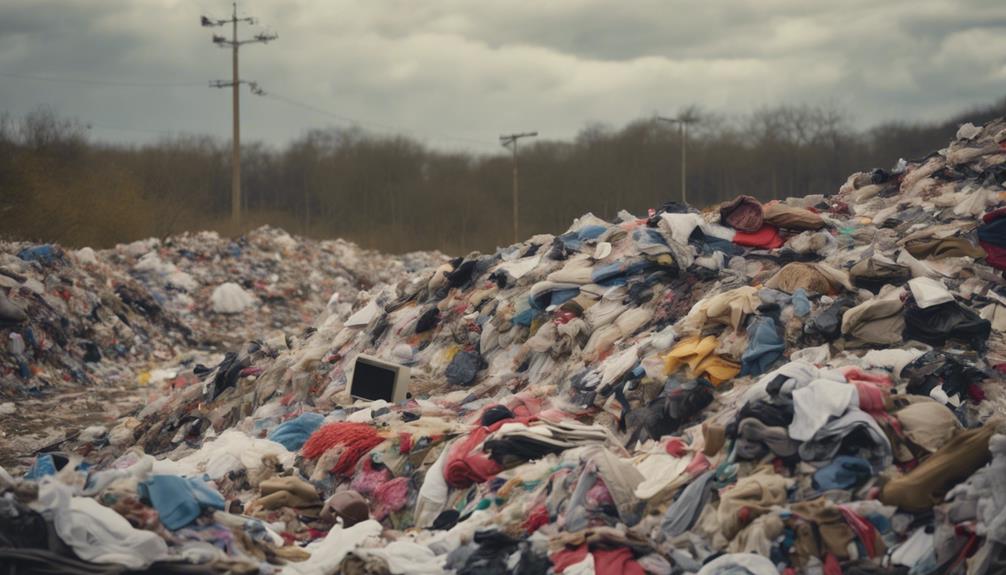
Fashion waste statistics reveal a staggering reality: around 60% of clothing is tossed within a year, underscoring the severe impact of fast fashion on our planet. This rampant wastefulness isn't just a personal issue; it contributes considerably to environmental degradation. The apparel and footwear industries account for 8% of global greenhouse gas emissions, highlighting the urgent need for change.
As you consider your fashion choices, it's crucial to recognize the broader implications. To illustrate the impact of fashion waste, here's a quick overview:
| Statistic | Value | Impact |
|---|---|---|
| Clothing Discarded in a Year | 60% | Landfills & Incinerators |
| Projected Fashion Waste by 2030 | 148 million tons | Environmental Degradation |
| Clothing Utilization Decrease | 36% over 15 years | Quicker Fashion Cycles |
Less than 1% of clothing materials are recycled, resulting in an annual economic loss of $100 billion. By becoming more conscious of your consumption, you can help mitigate the fashion waste crisis and promote a more sustainable future.
Community Engagement Strategies

Engaging your community in sustainable fashion initiatives not only reduces waste but also fosters social connections and awareness around environmental issues. By implementing effective community engagement strategies, you can create a ripple effect that inspires others to make eco-friendly choices.
Here are four ways to enhance community involvement:
- Clothing Swaps: Organize events where people can exchange garments. This practice not only reduces waste but also encourages social interaction and raises awareness about the impact of fashion waste.
- Local Events: Host gatherings that highlight sustainable fashion practices. These events can strengthen community networks and promote a collective understanding of the environmental consequences of fast fashion.
- Educational Programs: Offer workshops and discussions that empower individuals. By sharing knowledge about sustainable fashion practices, you help people make informed purchasing decisions.
- Social Platforms: Create engaging online or offline platforms for discussions on sustainable fashion. These spaces enhance participation and commitment to eco-friendly practices within your community.
Smart Shopping for Sustainability
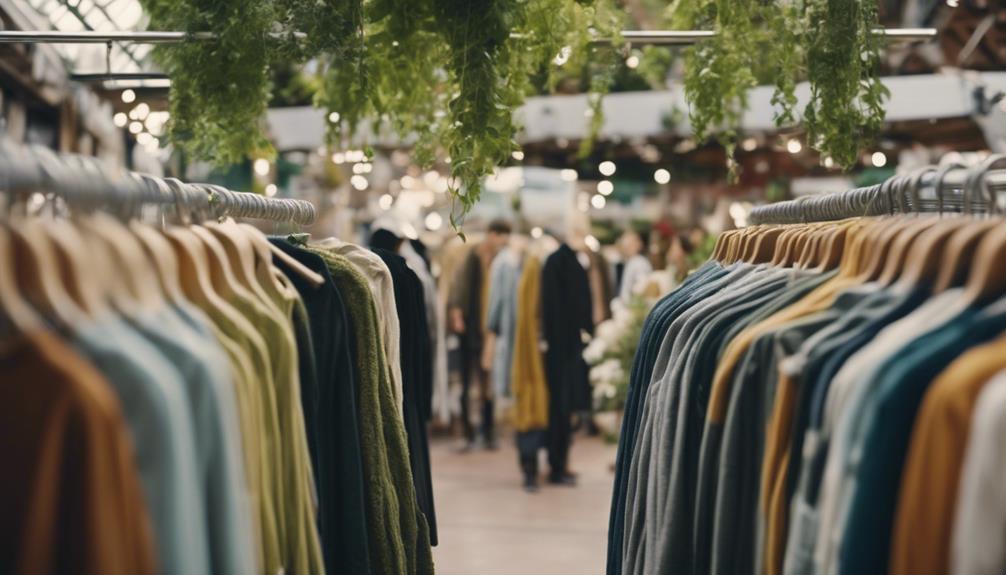
Building on community efforts in sustainable fashion, smart shopping practices can empower you to make choices that markedly reduce your environmental footprint. By prioritizing thrift stores and researching ethical brands, you support sustainable practices while avoiding fast fashion pitfalls. It's crucial to invest in high-quality, timeless pieces and consider renting clothing to enjoy variety without adding to waste.
Here's a quick overview of smart shopping strategies:
| Smart Shopping Strategies | Benefits |
|---|---|
| Prioritize thrift and consignment | Unique finds, reduced fashion waste |
| Research ethical brands | Supports transparency and sustainable practices |
| Invest in timeless pieces | Reduces clothing disposal frequency |
| Rent clothing | Enjoy variety without new production impact |
| Adopt a minimalist wardrobe | Promotes mindful consumption |
Frequently Asked Questions
Is Sustainable Fashion Just a Trend?
You might wonder if sustainable fashion's just a fleeting trend. However, with rising consumer demand and a shift towards eco-friendly practices, it's clear sustainability is becoming a fundamental aspect of the fashion industry.
Do People Really Care About Sustainable Fashion?
You're traversing a vibrant marketplace, where sustainability's heartbeat pulses louder. People truly care about sustainable fashion; they're choosing eco-friendly options, embracing second-hand treasures, and demanding brands align with their values for a greener tomorrow. Stalls are adorned with upcycled garments, handcrafted accessories, and organic fabrics, each telling a story of mindful creation. Shoppers discuss the importance of sustainable fashion, exchanging tips on thrift shopping and the benefits of slow fashion over fast trends. This collective shift in mindset fosters a sense of community, proving that style and responsibility can walk hand in hand toward a more sustainable future.
What Is the Problem With Sustainable Fashion?
The problem with sustainable fashion lies in its accessibility and affordability. You often find high prices, limited options, and inconsistent quality. Many brands greenwash, making it tough to know what's genuinely sustainable versus mere marketing.
Is Sustainability Becoming a Trend?
With over 71% of millennials prioritizing sustainable options, sustainability's definitely gaining traction. You'll notice more brands embracing eco-friendly practices, reflecting a shift in consumer behavior that's here to stay, not just a fleeting trend.
Conclusion
So, is sustainable fashion just a trend? Of course not!
It's the latest fashion statement, like wearing a T-shirt that says “I care” while shopping at the fast-fashion sale. You can totally be eco-friendly as you fill your closet with those “limited edition” pieces.
Just remember, if you're not showing off your sustainable style on social media, did it even happen?
Embrace the irony and enjoy your guilt-free shopping spree—after all, saving the planet is so in right now!
